14.1 points, 6.9 rebounds, .6 assists, 1.2 turnovers, 1.2 blocks, 52% FG, 76% FT
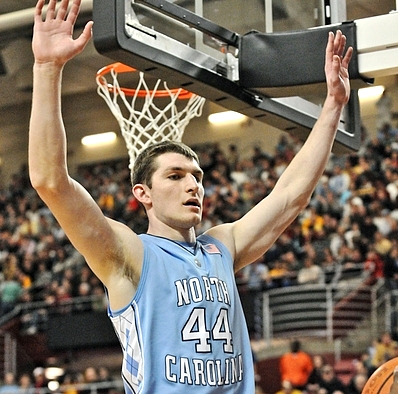
Walker Beeken
Following two injury-plagued seasons, Tyler Zeller has emerged as the leading scorer on a talented North Carolina team as a junior. Although he may not possess the upside of teammates John Henson and Harrison Barnes, his solid play has caught the attention of the many NBA scouts watching the Tar Heels this season.
Starting at the center position, Zeller is extremely mobile for a player his size, which fits perfectly into North Carolina's up tempo system. And while his team has had some struggles this season, Zeller has probably been their most consistent performer, highlighted by his 27 point, 11 rebound effort in a win against Kentucky, and a 24 point, 13 rebound effort against Duke this week.
As we've mentioned before, Zeller has the physical tools to stand out at the college level, as there aren't many players with his combination of size, mobility, and skill level. While not a top-shelf athlete, he runs the floor well and is able to elevate to finish and compete on the glass. His lack of physical strength is still his biggest weakness from a physical standpoint and area where he should really focus. It's hard to imagine him playing center in the NBA with his frame right now, but if he's able to add some strength, that may be where his game is best suited.
Just over 42% of Zeller's offensive possessions this season have come of the post up variety, and while he's shown that he's capable of scoring in the block, he still lacks some polish. His go-to move is his jump hook turning to his left shoulder from either block, which he executes effectively for the most part, but he sometimes forces the issue and shoots it from too far away or without reading the defense. He has managed to cut back on his turnover rate this season and get to the free throw line more often, which are both encouraging signs, but with his skill level and touch around the basket, he should be more efficient on the block than the .92 points per possession he's scoring this season on post up opportunities.
Zeller hasn't shown a whole lot in terms of his ability to shoot the basketball, as he's attempted less than one jump shot per game so far this season. Much of this can likely be attributed to him knowing his role and focusing on his strengths in the basket area though, as he seems to be a better shooter than what he's shown so far at North Carolina. He has a quick release and high release point and seems comfortable shooting the ball out to about 18 feet or so, and the fact that he shoots a solid 76% from the free throw line further demonstrates his potential in this area. When projecting him to the NBA, Zeller will likely need to spend more time facing the basket, whether it's off the pick-and-pop or just spacing the floor for dribble penetration.
The biggest issue with Zeller's NBA prospects is figuring out who he'll be able to defend. He does appear to be a guy who will put a solid effort in, but he gets muscled around at the college level, and his underdeveloped body would show up even more in the NBA. His lack of lateral quickness also hurts him covering the perimeter, making him vulnerable to quicker big men facing him up. Furthermore, he doesn't appear to be the toughest guy around, something that shows up in particular on the defensive glass, where he ranks just 38th of the 43 collegiate centers in our database when adjusting for minutes and pace.
Overall, there are quite a few positives for Zeller and draft stock. With teams always searching for quality big men, he is a very intriguing prospect with his combination of size, mobility, and emerging skill set that shows room for growth. He's shown this season that he's an effective scorer who seems to know his limitations and can fit into a team concept, and if scouts believe he's capable of improving his body, adding polish to his post game, and continuing to develop a reliable mid-range jump shot, he'll be a player who NBA teams will likely consider in the first round of the draft, whether it be in 2011 or 2012.
D.J. Kennedy, 6'6, Senior, Small Forward, St. John's
10.1 Points, 5.6 Rebounds, 2.1 Assists, 1.6 Turnovers, 1.7 Steals, 47% FG, 35% 3P, 74% FT
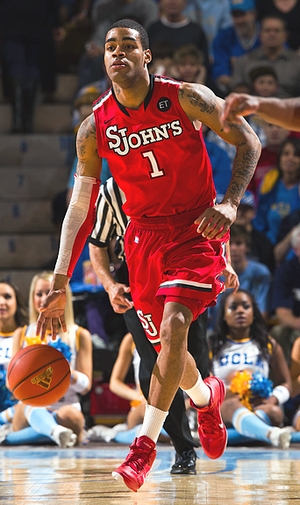
Matt Williams
A player we were watching closely coming into this season, D.J. Kennedy has not taken a big step forward in his first year under new Head Coach Steve Lavin. While St. John's is on pace to improve on their 6-12 conference record from last season, Kennedy has not taken his game to the next level despite playing a key part in his team's improvement.
As we noted the last time we wrote about him in December of 2009, Kennedy is a fluid and solid, albeit unspectacular, athlete who offers intriguing versatility and good size on the wing. The Pittsburgh native does a number of things well, but he hasn't made the jump as a scorer that would have propelled him firmly into draft conversations, instead seeing his numbers regress across the board this season.
Some of Kennedy's statistical regression can be attributed to the role he's playing. After spending a significant amount of time running the pick and roll as a junior, Kennedy has seldom had a chance to exploit his size, basketball IQ, and passing ability in the two-man game this season. On top of that, he has looked to put the ball on the floor and get to the rim substantially more often, reeling in his penchant for shooting jump shots from beyond the arc.
Seeing fewer touches as a primary ball-handler, shooting less than half as many three-pointers and 3.2 fewer shots per-game than he did last season, and willingly deferring to his fellow seniors, it isn't surprising to see Kennedy's numbers take a hit. Even at this level he appears most comfortable as a role player, which meshes well with what he'd be expected to do at the next level.
Though Kennedy hasn't been able to handle the ball as regularly as he used to, he still flashes a smooth floor game and the ability to push the ball himself in transition. A fairly heady passer, he has looked to pick and choose his spots in transition and half court sets. Not as aggressive as a shooter, he's done most of his damage on the fast break.
When the game slows down, Kennedy has shot the ball reasonably well this season, but simply doesn't attempted that many jumpers. Having knocked down some 37% of his jump shots according to Synergy Sports Technology, he has shown reliable mechanics with his feet set, but has struggled to knock down shots off the dribble. Lacking the ability to create separation at will attacking the rim and altering his form when defended, the lefty wing was more efficient off the dribble last season when he was hoisting up shots from the perimeter working off of screens.
Defensively, Kennedy is an exceptional stopper at the NCAA level. Whether he's cleaning the glass, contesting shots, or cutting off penetration, his defensive ability is impressive and ranks as one of his best assets as a prospect.
Similar to former Memphis Tiger Antonio Anderson on a number of levels, Kennedy has never been one to blow anyone away on first glance, and his role at the next level would unquestionably be as a role player. Despite taking a step back this season, Kennedy remains one of the more versatile wings in the senior class, and is completely capable of showing well at the Portsmouth Invitational Tournament should he elect to attend.
Greg Smith, 6-10, Sophomore, Center, Fresno State, 11.7 points, 7.4 rebounds, 1.7 assists, 1.8 turnovers, 1.2 steals, 1.1 blocks, 59.4% FG, 54.5% FT
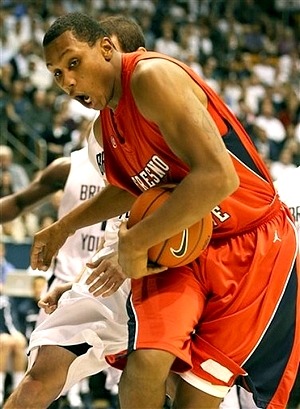
Kyle Nelson
Center Greg Smith had an impressive freshman campaign, but he has failed to distinguish himself as a sophomore for the 11-12 Fresno State bulldogs.
At 6'10 with solid length and a stocky 250-pound frame, Smith is big enough to play either post position at the next level. While he is not overly quick or explosive, he is a solid and coordinated athlete with above average mobility given his size.
Smith was expected to assume greater offensive responsibilities with the departures of Paul George and Sylvester Seay, but, he has actually seen his role reduced. His production has dropped from 16.7 points per 40 minutes pace adjusted as a freshman, to just 15.2 as a sophomore. His lack of production is particularly frustrating not only given his physical advantages in the post at this level, but also considering the skill level that he shows with his back to the basket.
Smith receives over 40% of his offensive possessions on post-ups, where he continues to show the same combination of soft hands and basic footwork. His 59.8% 2FG represents how efficient he is as a post scorer. He looks particularly comfortable this season executing a spin move to his left hand.
For the most part, however, his skill set has not improved since last season. He must continue to work on expanding his game, primarily getting more comfortable going right and developing more advanced footwork. Furthermore, while he has gotten to the line at a slightly greater rate this season, he is still an abysmal foul shooter to the tune of 54.5% while showing very little potential as a spot-up shooter at this stage.
Smith shows improved decision making abilities, however, cutting down on his turnovers and fouls while displaying improved passing and off-the-ball movement. Unfortunately, his motor still runs hot and cold, which leads to periods of ineffectiveness and invisibility on the offensive end. This, in addition to Fresno State's miserable offensive execution, likely explains his mediocre production and usage rate.
Inconsistency defines Smith's defensive performance, as well. While his size, bulk, and solid mobility should help him stand his ground in the post with relative ease at this level, he struggles with focus. Far too often, his man beats him with a simple fake or countermove and Smith is forced to foul to compensate for his poor effort.
While he is still a below average rebounder given his size and athleticism, he noticeably improved on the defensive boards on his way to a far more respectable 9.6 rebounds per 40 minutes pace adjusted. Nevertheless, it is in this area where his lack of activity and effort are most evident and he still has a lot to prove to scouts.
For these reasons, Smith remains both a legitimate prospect and an extremely frustrating player. He should be dominating mid-major collegiate competition with his physical advantages and ability to play with his back to the basket. Fresno State's shaky game plan and disorganized offense certainly isn't helping matters, but scouts will be watching to see if he can compensate by producing through hustle and sheer effort.
Aaric Murray, 6-10, PF/C, Sophomore, LaSalle
15.1 points, 7.8 rebounds, 1.1 assists, 2.2 blocks, 2.4 turnovers, 52% FG, 80% FT, 36% 3PT
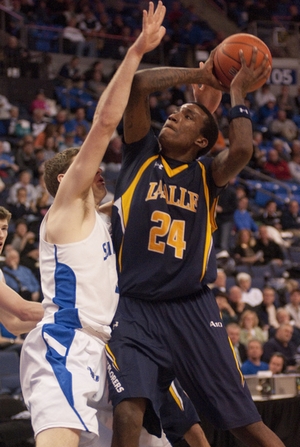
Joseph Treutlein
Coming off a solid freshman season, after which he toyed with entering the NBA draft, Aaric Murray has come back to make some modest improvements as a sophomore. While Murray has slightly increased his production and efficiency this year, there are also some things he's still struggling with, namely consistently playing with high effort and focus.
On the offensive end, Murray has the makings of a versatile inside-out game, being serviceable scoring the ball in variety of ways but not great in any one area. The majority of his possessions come off cuts, offensive rebounds, and pick-and-rolls, with him being pretty active getting open and looking for ways to score off the ball. He has good hands, coordination, and mobility, which enable him to get a lot of opportunities, but his lack of noteworthy explosiveness or reactiveness hurts his ability to finish around the basket, specifically when contested.
On the perimeter, Murray showed great potential as a shooter last season, having a great knack for putting the ball in the basket despite unrefined and inconsistent shooting mechanics. He shot 36% from behind the arc last year, and is hitting at the same clip this season, but his attempts are down from 2.9 to 1.2 per game, with him placing more of an emphasis on mid-range shots instead.
At his size with his natural ability, Murray has the potential to be a very potent weapon as a three-pointer shooter, but he too often settles for ill-advised, contested shots and doesn't show much effort in keeping his mechanics consistent. At times he looks excellent knocking down spot-up shots, and he's shooting a very strong 80% from the free-throw line, but his lack of discipline and unpolished mechanics are severely holding him back.
The one area where Murray has probably improved the most this season is with his back-to-the-basket, as he shows a decent developing array of moves in the post, having excellent touch on his right-handed hook shot and the ability to pull up some rangy dropsteps and spin moves. His lack of explosiveness and power hold him back in this area, and it's questionable how his game at this point would translate against higher caliber defenders, though he shows potential here and is still developing.
Murray also improved the rate at which he gets to the free throw line this season, averaging 3.9 FTA per game compared to 2.0 last season, but he still doesn't get to the line as much as you'd like for a player with his tools who shoots free throws as well as he does.
On the defensive end is where Murray is having the most trouble this season, as his effort and focus are continual causes for concern, which led to him playing just 11 minutes in a game against Dayton earlier this week. Murray frequently just goes through the motions on this end, most notably in the way he easily gives up position on the low block, while he's also prone to giving up on plays and letting out of his stance. His fundamentals in the post are not good, though he does do a good job using his length and mobility to block shots at a solid rate both on and off the ball. To his credit, he actually shows some potential defending the perimeter, occasionally showing a solid stance and having the mobility to move around well, but he too often lets out of his stance and just doesn't put in the effort moving his feet.
On the glass, Murray is likewise not very impressive, doing a good job on the offensive glass, but not being especially active on the defensive boards, pulling in just 6.1 defensive boards per 40 minutes pace adjusted. His lack of consistent energy doing the little things is concerning, as his offensive skill level probably isn't at the point where he can make it in the long term unless he's making consistent contributions on defense and the boards.
Looking forward, Murray is an intriguing player with his size, skill-level, and potential as a three-point shooter, while he makes solid contributions in a few other areas as well. As a 21-year-old sophomore who doesn't always show great energy on the floor, however, it's fair to question how likely he is to reach his potential. The fact that he rates as a below average athlete at best for the NBA level doesn't help matters either.
Murray's size and scoring instincts could put him in second round discussions come June, even if he's not a lock to get drafted considering his advanced age, the red flags surrounding him and the underwhelming progress he's made this season.













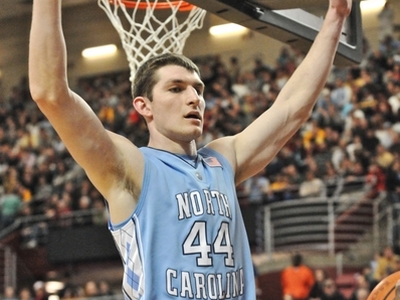





















Comments